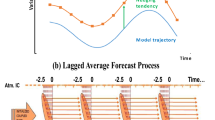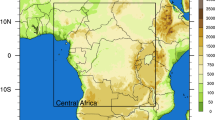Abstract
Forecast skill of the APEC Climate Center (APCC) Multi-Model Ensemble (MME) seasonal forecast system in predicting two main types of El Niño-Southern Oscillation (ENSO), namely canonical (or cold tongue) and Modoki ENSO, and their regional climate impacts is assessed for boreal winter. The APCC MME is constructed by simple composite of ensemble forecasts from five independent coupled ocean-atmosphere climate models. Based on a hindcast set targeting boreal winter prediction for the period 1982–2004, we show that the MME can predict and discern the important differences in the patterns of tropical Pacific sea surface temperature anomaly between the canonical and Modoki ENSO one and four month ahead. Importantly, the four month lead MME beats the persistent forecast. The MME reasonably predicts the distinct impacts of the canonical ENSO, including the strong winter monsoon rainfall over East Asia, the below normal rainfall and above normal temperature over Australia, the anomalously wet conditions across the south and cold conditions over the whole area of USA, and the anomalously dry conditions over South America. However, there are some limitations in capturing its regional impacts, especially, over Australasia and tropical South America at a lead time of one and four months. Nonetheless, forecast skills for rainfall and temperature over East Asia and North America during ENSO Modoki are comparable to or slightly higher than those during canonical ENSO events.












Similar content being viewed by others
Notes
1986, 1990, 1991, 1992, 1994, 2002, 2004, and 2009.
1982–1983, 1987–1988, 1997–1998, 2006–2007, and 2010.
The area-averaged sea surface temperature anomaly over the region bounded by (5°S–5°N, 150°W–90°W) is known as Niño3 index, which is a well-known ENSO index.
The El Niño Modoki index or EMI is defined as EMI = [SSTA]C − 0.5[SSTA]E − 0.5[SSTA]W, where the square bracket with a subscript represents the area-mean SSTA, averaged over one of the three regions specified as the central (C: 165°E–140°W, 10°S–10°N), eastern (E: 110°W–70°W, 15°S–5°N), and western (W: 125°E–145°E, 10°S–20°N).
From linear considerations associated with the regression method, we can expect that the impacts of La Niña (La Niña Modoki) are opposite to those of El Niño (El Niño Modoki). As it can be seen, the limitation stems from the fact that the non-linearity in the impacts is not addressed.
Australasia is defined by a region of Oceania comprising Australia, New Zealand, and neighboring islands in the southwest Pacific Ocean.
References
Adler RF, Huffman GJ, Chang A, Ferraro R, Xie P, Janowiak J, Rudolf B, Schneider U, Curtis S, Bolvin D, Gruber A, Susskind J, Arkin P, Nelkin E (2003) The version-2 global precipitation climatology project (GPCP) monthly precipitation analysis (1979–present). J Hydrometeorol 4:1147–1167
Ashok K, Behera S, Rao AS, Weng HY, Yamagata T (2007) El Niño Modoki and its teleconnection. J Geophys Res 112:C11007. doi:10.1029/2006JC003798
Ashok K, Tam CY, Lee WJ (2009a) ENSO Modoki impact on the Southern Hemisphere storm track activity during extended austral winter. Geophys Res Lett 36:L12705. doi:10.1029/2009GL038847
Ashok K, Iizuka S, Rao SA, Saji NH, Lee WJ (2009b) Processes and boreal summer impacts of the 2004 El Niño Modoki: an AGCM study. Geophys Res Lett 36:L04703. doi:10.1029/2008GL036313
Cai W, Cowan T (2009) La Niña Modoki impacts Australia autumn rainfall variability. Geophys Res Lett 36:L12805. doi:10.1029/2009GL037885
Collins WD, Bitz CM, Blackmon ML, Bonan GB, Bretherton CS, Carton JA, Chang P, Doney SC, Hack JJ, Henderson TB, Kiehl JT, Large WG, McKenna DS, Santer BD, Smith RD (2006) The community climate system model version 3 (CCSM3). J Clim 19(11):2122–2143
Diaz HF, Hoerling MP, Eischeid JK (2001) ENSO variability, teleconnections and climate change. Int J Climatol 21:1845–1862
Donguy JR, Dessier A (1983) El Nino-like events observed in the tropical Pacific. Mon Weather Rev 111:2136–2139
Fu C, Diaz H, Fletcher J (1986) Characteristics of the response of sea surface temperature in the central Pacific associated with warm episodes of the Southern Oscillation. Mon Weather Rev 114:1716–1739
Ham YG, Kang IS (2010) Improvement of seasonal forecasts with inclusion of tropical instability waves on initial conditions. Clim Dyn. doi:10.1007/s00382-010-0743-0
Hendon HH, Lim E, Wang G, Alves O, Hudson D (2009) Prospects for predicting two flavors of El Niño. Geophys Res Lett 36:L19713. doi:10.1029/2009GL040100
Jeong HI, Ashok K, Song BG, Min YM (2008) Experimental 6-month Hindcast and forecast simulation using CCSM3. APCC 2008 Technical Report, APEC Climate Center
Jin EK, Kinter JL III, Wang B, Park CK, Kang IS, Kirtman BP, Kug JS, Kumar A, Luo JJ, Schemm J, Shukla J, Yamagata T (2008) Current status of ENSO prediction skill in coupled O-A models. Clim Dyn 31:647–664. doi:10.1007/s00382-008-0397-3
Kanamitsu M, Kumar A, Juang HMH, Wang W, Yang F, Schemm J, Hong SY, Peng P, Chen W, Ji M (2002) NCEP dynamical seasonal forecast system 2000. Bull Am Meteorol Soc 83:1019–1037
Kao HY, Yu JY (2009) Contrasting eastern-Pacific and central-Pacific types of ENSO. J Clim 22:615–632. doi:10.1175/2008JCLI2309.1
Kiehl JT, Shields CA, Hack JJ, Collins WD (2006) The climate sensitivity of the community climate system model version 3 (CCSM3). J Clim 19:2584–2596
Krishnamurti TN, Kishtawal CM, Shin DW, Williford CE (2000) Multi-model superensemble forecasts for weather and seasonal climate. J Clim 13:4196–4216. doi:10.1175/1520-0442(2000)013<4196:MEFFWA>2.0.CO;2
Kug JS, Lee JY, Kang IS (2008) Systematic error correction of dynamical seasonal prediction using a stepwise pattern projection method. Mon Weather Rev 136:3501–3512. doi:10.1175/2008MWR2272.1
Kug JS, Jin FF, An SI (2009) Two types of El Niño events: cold tongue El Niño and warm pool El Niño. J Clim 22:1499–1515
Kug JS, Ahn MS, Sung MK, Yeh SW, Min HS, Kim YH (2010) Statistical relationship between two types of El Niño events and climate variation over the Korean Peninsula. Asia Pac J Atmos Sci 46:467–474. doi:10.1007/s13143-010-0027-y
Larkin NK, Harrison DE (2005a) On the definition of El Nino and associated seasonal average U.S. weather anomalies. Geophys Res Lett 32:L13705. doi:10.1029/2005GL022738
Larkin NK, Harrison DE (2005b) Global seasonal temperature and precipitation anomalies during El Nino autumn and winter. Geophys Res Lett 32:L16705. doi:10.1029/2005GL022860
Lee JY, Wang B, Kang IS, Shukla J, Kumar A, Kug JS, Schemm J, Luo JJ, Yamagata T, Fu X (2010) How are seasonal prediction skills related to models’ performance on mean state and annual cycle? Clim Dyn 35:267–283. doi:10.1007/s00382-010-0857-4
Lee DY, Ashok K, Ahn JB (2011a) Toward enhancement of prediction skills of multimodel ensemble seasonal prediction: a climate filter concept. J Geophys Res 116:D06116. doi:10.1029/2010JD014610
Lee JY, Wang B, Ding Q, Ha KJ, Ahn JB, Kumar A, Stern B, Alves O (2011b) How predictable is the northern hemisphere summer upper-tropospheric circulation? Clim Dyn 37:1189–1203. doi:10.1007/s00382-010-0909-9
Lim EP, Hendon HH, Hudson D, Wang G, Alves O (2009) Dynamical forecast of inter–El Niño variations of tropical SST and Australian spring rainfall. Mon Weather Rev 137:3796–3810. doi:10.1175/2009MWR2904.1
Luo JJ, Masson S, Behera S, Shingu S, Yamagata T (2005) Seasonal climate predictability in a coupled OAGCM using a different approach for ensemble forecasts. J Clim 18:4474–4497
McPhaden MJ (1999) Genesis and evolution of the 1997–1998 El Niño. Science 283:950–954
Meehl GA, Arblaster JM, Lawrence DM, Seth A, Schneider EK, Kirtman BP, Min D (2006) Monsoon regimes in the CCSM3. J Clim 19:2482–2495
Mo KC (2010) Interdecadal modulation of the impact of ENSO on precipitation and temperature over the United States. J Clim 23:3639–3656. doi:10.1175/2010JCLI3553.1
Pradhan PK, Preethi B, Ashok K, Krishnan R, Sahai AK (2011) Modoki, Indian Ocean Dipole, and western North Pacific typhoons: Possible implications for extreme events. J Geophys Res 116:D18108. doi:10.1029/2011JD015666
Rasmusson EM, Carpenter TH (1982) Variation in tropical sea surface temperature and surface wind fields associated with Southern Oscillation/El Nino. Mon Wea Rev 110:354–384
Ratnam JV, Behera SK, Masumoto Y, Takahashi K, Yamagata T (2010) Pacific Ocean origin for the 2009 Indian summer monsoon failure. Geophys Res Lett 37:L07807. doi:10.1029/2010GL042798
Reynolds RW, Rayner NA, Smith TM, Stokes DC, Wang W (2002) An improved in situ and satellite SST analysis for climate. J Clim 15:1609–1625
Ropelewski CF, Halpert MS (1987) Global and regional scale precipitation patterns associated with the El Nino/Southern Oscillation. Mon Weather Rev 115:1606–1626
Ropelewski CF, Halpert MS (1989) Precipitation patterns associated with the high index phase of the Southern Oscillation. J Clim 2:268–284
Saha S, Nadiga S, Thiaw C, Wang J, Wang W, Zhang Q, Van den Dool HM, Pan HL, Moorthi S, Behringer D, Stokes D, Penã M, Lord S, White G, Ebisuzaki W, Peng P, Xie P (2006) The NCEP climate forecast system. J Clim 19:3483–3517
Saji NH, Yamagata T (2003) Possible impacts of Indian Ocean dipole mode events on global climate. Clim Res 25:151–169
Tanaka HL, Ishizaki N, Kitoh A (2004) Trend and interannual variability of walker, monsoon and Hadley circulations defined by velocity potential in the upper troposphere. Tellus 56A:250–269
Taschetto AS, England MH (2009) El Niño Modoki impacts on Australian rainfall. J Clim 22:3167–3174. doi:10.1175/2008JCLI2589.1
Trenberth KE, Smith L (2009) Variations in the three dimensional structure of the atmospheric circulation with different flavors of El Niño. J Clim 22:2978–2991. doi:10.1175/2008JCLI2691.1
Trenberth KE, Stepaniak DP (2001) Indices of El Nino evolution. J Clim 14:1697–1701
Turner, AG, Inness PM, Slingo JM (2007) The effect of doubled CO2 and model basic state biases on the monsoon-ENSO system. II: changing ENSO regimes Q J Roy Meteor Soc 133(Part A):1159–1173
Wang G, Hendon HH (2007) Sensitivity of Australian rainfall to inter-El Nino variations. J Clim 20:4211–4226
Wang B, Lee JY, Kang IS, Shukla J, Kug JS, Kumar A, Schemm J, Luo JJ, Yamagata T, Park CK (2008) How accurately do coupled climate models predict the leading modes of Asian-Australian monsoon interannual variability? Clim Dyn 30:605–619
Wang B, Lee JY, Kang IS, Shukla J, Park CK, Kumar A, Schemm J, Cocke S, Kug JS, Luo JJ, Zhou T, Wang B, Fu X, Yun WT, Alves O, Jin EK, Kinter J, Kirtman B, Krishnamurti T, Lau NC, Lau W, Liu P, Pegion P, Rosati T, Schubert S, Stern W, Suarez M, Yamagata T (2009) Advance and prospectus of seasonal prediction: assessment of the APCC/CliPAS 14-model ensemble retrospective seasonal prediction (1980–2004). Clim Dyn 33:93–117
Weng H, Ashok K, Behera SK, Rao SA, Yamagata T (2007) Impacts of recent El Nino Modoki on dry/wet conditions in the Pacific rim during boreal summer. Clim Dyn 29:113–129
Weng H, Behera SK, Yamagata T (2009) Anomalous winter climate conditions in the Pacific rim during recent El Niño Modoki and El Niño events. Clim Dyn 32:663–674. doi:10.1007/s00382-008-0394-6
Yeh SW, Kug JS, Dewitte B, Kwon MH, Kirtman BP, Jin FF (2009) El Nino in a changing climate. Nature 461:511–514. doi:10.1038/nature08316
Yu JY, Kao HK (2007) Decadal changes of ENSO persistence barrier in SST and ocean heat content indices: 1958–2001. J Geophys Res 112:D13106. doi:10.1029/2006JD007654
Yu JY, Kim ST (2010) Three evolution patterns of Central‐Pacific El Niño. Geophys Res Lett 37:L08706. doi:10.1029/2010GL042810
Yun WT, Stefanova L, Mitra AK, Kumar T, Dewar W, Krishnamurti TN (2005) A multi-model superensemble algorithm for seasonal climate prediction using DEMETER forecasts. Tellus Ser A 57:280–289
Zhao M, Hendon HH (2009) Representation and prediction for the Indian Ocean dipole in the POAMA seasonal forecast model. Q J Roy Meteorol Soc 135:337–352
Acknowledgments
The authors appreciate the participating institutes of the APCC coupled MME prediction system for providing the hindcast experiment data. Discussion with Prof. B. Wang is acknowledged. J.-B. Ahn was supported by the Korea Meteorological Administration Research and Development Program under Grant CATER 2012-3083. K. Ashok acknowledges the support of Prof. B. N. Goswami, Director, IITM (fully funded by MoES, Government of India), and the MoES for the SAPRISE support under the MoES-NERC grant. Views expressed herein wholly are of the authors and do not reflect the views of the organizations they are affiliated to.
Author information
Authors and Affiliations
Corresponding author
Rights and permissions
About this article
Cite this article
Jeong, HI., Lee, D.Y., Ashok, K. et al. Assessment of the APCC coupled MME suite in predicting the distinctive climate impacts of two flavors of ENSO during boreal winter. Clim Dyn 39, 475–493 (2012). https://doi.org/10.1007/s00382-012-1359-3
Received:
Accepted:
Published:
Issue Date:
DOI: https://doi.org/10.1007/s00382-012-1359-3




